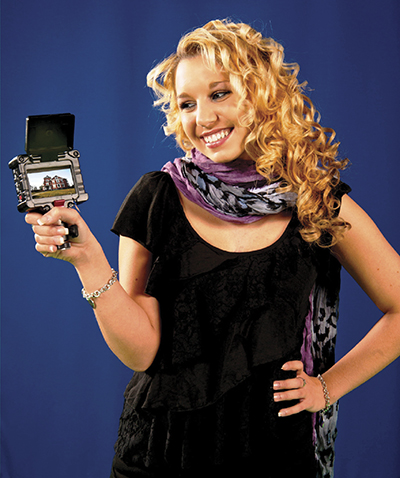Zacuto EVF Flip Portable Monitor
I can’t count the number of times I’ve needed to see the camera’s viewfinder and I was on the opposite end of a jib. Zacuto has offered a solution in its EVF Flip—a portable 3.2-inch high-resolution monitor that puts the camera’s viewfinder where you need it most.

The Zacuto EVF Flip portable monitorFEATURES
The Zacuto EVF Flip has the same size LCD screen as most DSLRs. A cover securely latches over the screen to protect its surface from scratches. If you’re facing the unit, the right side has two HDMI ports: out and in, allowing video to be looped through. The left side has four circular black buttons and a larger red button that powers the viewfinder. The top button activates the main menu allowing selection of screen settings (brightness, contrast, and chroma), color bars, battery level display, scaling, focus assist, zebra, image flip, zoom, audio meters, function buttons, and many other features. The second and third buttons scroll up or down the menu screen, with the fourth controlling your selections. A miniscule 7.4 volt lithium-ion battery in the rear powers the unit. An adjustable mount screws into the bottom of the EVF Flip allowing the hotshoe to be mounted.
At only 800 x 480, the resolution isn’t as sharp as some DSLRs, but it will display standard definition’s 480i/p, as well as high definition’s 720p and 1080i/p. Zacuto promises an 8.5-hour battery life, but in the real world it lasted only about six. The EVF Flip does have some very useful features such as the “frame lines” option on the menu. Four aspect ratios are available: 4:3, 16:9, 1.85:1, and 2.35:1. Seeing the grid helps in achieving these ratios.
IN USE
I quickly teamed the review model EVF Flip with Canon’s EOS 5D Marl II DSLR in a jib shoot project I’d lined up. I was unable to see the camera’s viewfinder when it was at the end of the extended jib arm; however, the supplied HDMI cable was long enough to reach from the Canon’s output to the input of the Zacuto monitor, providing an accurate view of what the camera was seeing. A slightly larger screen would have been better, but the only other monitor available was a 9-inch LCD that couldn’t display 1080p, making the EVF Flip a more viable choice. After selecting the 16:9 aspect ratio, I was ready to shoot in a matter of minutes.
The monitor can be easily swiveled or angled to provide better viewing in sunny situations, and the screen can be closed when transporting the unit, or if the weather becomes unpleasant.
The loop-through feature of the HDMI ports permits the director and other members of the crew to view the action from different locations. (As with most cameras, once you utilize a HDMI port, the viewfinder on the camera is deactivated.)
The EVP Flip also proved very useful on a Steadicam shoot. Our operator aligned the wide tracking shot without needing to see camera’s LCD screen. By using the extension cable, the director and I were able to evaluate the operator shots live—another great use of the EVP Flip.
The only negative is when shooting handheld. If the director wants to view the shot while the DP is shooting, attaching the EVF Flip renders the camera’s viewfi nder inoperable (at least on the Canon EOS 5D).
SUMMARY
Zacuto’s EVF Flip is a convenient way to put a multifunctional, portable LCD monitor exactly where you want it. Although it’s a bit on the expensive side, you do have much more control over the viewable image than many other portable LCD monitors on the market.
Chuck Gloman is an associate professor and chair of the TV/Film department at DeSales University. He may be contacted atchuck.gloman@desales.edu.
FAST FACTS
APPLICATION
General purpose portable video monitoring, especially when an external camera viewfinder is required
KEY FEATURES
Long-life rechargeable battery, latchable screen cover, multiple menu functions, and the ability to be mounted just about anywhere a portable picture monitor is needed
PRICE
MRSP $775
CONTACT
Zacuto
888-294-3456
www.zacuto.com
Get the TV Tech Newsletter
The professional video industry's #1 source for news, trends and product and tech information. Sign up below.
Chuck Gloman is Associate Professor with the TV/Film Department at DeSales University.

